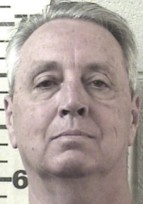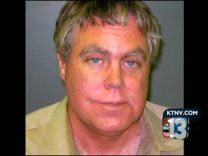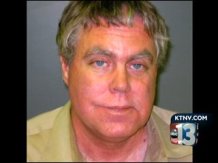LAS VEGAS, NEVADA – When Mitchell Crooks checked out of the county jail last month and checked into a Las Vegas hospital, the 36-year-old videographer knew he had a fight on his hands.
His face was bloodied and bruised. His $3,500 camera had been impounded by police, and he faced criminal charges for battery on a police officer.
One month later, things have changed for Crooks.
The Clark County district attorney’s office has dropped all charges, and Crooks has retained an attorney of his own. The Metropolitan Police Department has opened an internal investigation into the Las Vegas police officer, Derek Colling, whom Crooks says falsely arrested and beat him for filming police.
And his camera — which captured the entire March 20 altercation between Crooks and Colling — has been returned.
CAUGHT ON TAPE
The words are friendly enough, but the tone is tense:
“Can I help you, sir?” Colling asks from his patrol car after parking it in front of Crooks’ driveway and shining the spotlight on Crooks.
“Nope. Just observing,” Crooks responds, fixing his camera on the officer.
Crooks had for an hour been recording the scene across the street from his home in the 1700 block of Commanche Circle, near East Desert Inn Road and South Maryland Parkway, where officers had several young burglary suspects handcuffed and sitting on the curb.
As Las Vegas crimes go, the activity was fairly boring. But Crooks wanted to try out his new camera, and he figured his neighbors would like to see the suspects’ faces.
When Colling loaded suspects into the back of his car and drove in a circle through the cul-de-sac, Crooks said he thought police were leaving. Then the officer stopped his car.
“Do you live here?” Colling asks.
“Nope,” Crooks says.
Colling steps out of his patrol car.
Crooks said he now regrets not telling the officer that he was in fact standing in his own driveway. His realizes his response seemed cheeky, but he said the officer made him nervous.
Colling walks toward Crooks, his left hand raised.
“Turn that off for me,” Colling orders.
“Why do I have to turn it off?” Crooks responds. “I’m perfectly within my legal rights to be able to do this.”
The officer repeats the command several times; each time Crooks reiterates his right to film.
“You don’t live here,” Colling says, now close to Crooks.
“I do live here!”
“You don’t live here, dude.”
“I just said I live here!”
As Crooks backs away, Colling grabs him by the shoulder and throws him down. On the ground, Crooks grabs the camera and turns it toward his face.
Colling’s leg then enters the video frame. Crooks says he believes that was the kick that broke his nose.
The video doesn’t show it, but it the camera records Crook screaming. He said that’s when Colling was punching his face.
“Shut up!” Colling yells. “Stop resisting!”
‘A WORLD OF HURT’
In his arrest report Colling wrote that Crooks grabbed his shoulders “and attempted to take me to the ground. I in turn took him to the ground.”
At Clark County Detention Center, Crooks was booked for battery on a police officer and obstruction of justice. He was released from jail the next day. On March 26, the Review-Journal reported on his case. Four days later all charges were dropped.
Chief Deputy District Attorney Christopher Laurent said he dismissed the charges because the police report was vague.
“I asked for a more definite description of the battery, because battery requires a violent touching,” Laurent said. Police never provided that information, Laurent said, so the case was dropped.
Crooks said he always believed he’d be vindicated, but after police returned his camera he knew he had proof.
“I was confident I was doing the right thing, but I was excited they (the DA’s office) weren’t wasting any time, and that somebody was smart enough to know I was acting within the law,” he said.
Crooks said the incident looks worse on tape than he remembered.
What bothered him the most, he said, was Colling’s attitude after he was placed in handcuffs.
“Why did you do that? I live here,” Crooks is heard pleading on the tape.
“You just told me you didn’t live here,” Colling says. “You live right here, in this house?”
Crooks asks for paramedics. Colling tells him to shut up and follow orders.
“If you fight again, dude
Hey, if you (expletive) fight again, dude, you’re in a world of hurt. You hear me?
“You’re not in charge here, buddy. You hear me?”
Colling mocks Crooks’ labored breathing.
“Oh yeah, buddy. Hey, when you don’t do what I ask you to do, then you’re in a world of hurt. Then you’re in a world of hurt. Aren’t ya? Huh?”
Crooks was later diagnosed with a deviated septum and a chest wall injury. Crooks believes his ribs were broken, but never got X-rays that could prove it.
LAWYERS REACT
Allen Lichtenstein, an American Civil Liberties Union attorney, reviewed Crooks’ video and said Colling was clearly in the wrong. Officers are trained to avoid escalating situations, but Colling initiated the incident and created a physical confrontation without provocation, he said.
“It raises serious questions about whether the officer used good judgment and whether he was properly trained,” Lichtenstein said. “Those questions require answers.”
Police have no expectation of privacy, and it’s perfectly legal to film officers as long as it does not interfere in their investigation, he said.
Colling also erred in claiming that Crooks was trespassing. By law, only a property owner or resident can make a trespassing complaint, Lichtenstein said.
“Even if the officer didn’t think he lived there, that doesn’t mean he didn’t have permission to be there,” Lichtenstein said. “In the video I heard, that question was never asked.”
Crooks’ attorney, David Otto, on Thursday sent police a statement from Crooks, along with a demand for $500,000 to cover Crooks’ medial care, pain and suffering.
Colling had no legitimate reason to approach Crooks that night, Otto wrote.
“Officer Colling was aggravated that a citizen should have the audacity to video tape, him — a Las Vegas Metropolitan Patrol Officer,” Otto wrote. “Officer Colling decided to use the fear and terror of his physical ability to beat Mr. Crooks into submission — to teach Mr. Crooks and, by example, all citizens and residents of the Las Vegas Valley.”
Clark County Sheriff Doug Gillespie declined comment, saying the internal investigation remains open. Collings remains on duty, and department officials noted that Crooks has declined several requests to be interviewed by detectives.
The suspects in Colling’s patrol car may have witnessed the event and given statements to detectives, but their names have not been released. Police said they were not arrested or booked, so their names are not public record.
Crooks said he doesn’t want to talk to detectives.
A HISTORY OF VIOLENCE
Neither Colling nor Crooks are strangers to controversy.
Colling has been involved in two fatal shootings in his 5 1/2 years as a Las Vegas police officer. In 2006, he and four other officers shot Shawn Jacob Collins after the 43-year-old man pulled a gun at an east valley gas station.
In 2009, he confronted a mentally ill 15-year-old Tanner Chamberlain, who was holding a knife in front of his mother and waving it in the direction of officers. Colling shot him in the head.
Both shootings were ruled justified by Clark County coroner’s juries.
Crooks made headlines in 2002 when he videotaped two Inglewood, Calif., police officers beating a 16-year-old boy. One officer was fired and criminally charged but was not convicted after two trials ended with hung juries. The incident strained race relations in Southern California — the police officer was white, the teenager black.
Crooks first tried to sell that tape and then declined to give it to prosecutors. He was then jailed on old warrants from unrelated drunken driving and petty theft charges. Civil rights advocates decried it as retribution.
In 2003 he moved to Las Vegas, where he makes a living, among other things, shooting video for nightclubs, and says he kept out of trouble right up until the night he met officer Colling.
Appeared Here



 Posted by mustbme
Posted by mustbme  SPRING CREEK, NEVADA – A city officer arrested a Spring Creek man Wednesday morning at the Elko Area Regional Airport, where he works for the Transportation Security Administration, on a warrant charging six counts of lewdness with a child.
SPRING CREEK, NEVADA – A city officer arrested a Spring Creek man Wednesday morning at the Elko Area Regional Airport, where he works for the Transportation Security Administration, on a warrant charging six counts of lewdness with a child. LAS VEGAS, NEVADA – David Schubert, a Clark County deputy district attorney who prosecuted a pair of high-profile celebrity drug cases, has resigned following his arrest last month on charges of cocaine possession, according to a spokeswoman for the district attorney’s office.
LAS VEGAS, NEVADA – David Schubert, a Clark County deputy district attorney who prosecuted a pair of high-profile celebrity drug cases, has resigned following his arrest last month on charges of cocaine possession, according to a spokeswoman for the district attorney’s office. SAN DIEGO, CALIFORNIA — Two Navy helicopter pilots from North Island Naval Air Station have been grounded over a YouTube video that allegedly shows them dipping the $33 million aircrafts into Lake Tahoe.
SAN DIEGO, CALIFORNIA — Two Navy helicopter pilots from North Island Naval Air Station have been grounded over a YouTube video that allegedly shows them dipping the $33 million aircrafts into Lake Tahoe. PAHRUMP, NV – New information is being released about the dui arrest of Nye County District Attorney Bob Beckett. It turns out a former madam is responsible for the 911 call that led police to Beckett’s car.
PAHRUMP, NV – New information is being released about the dui arrest of Nye County District Attorney Bob Beckett. It turns out a former madam is responsible for the 911 call that led police to Beckett’s car. PAHRUMP, NEVADA – A rural Nevada district attorney is in trouble again after an overnight arrest on a drunken driving charge.
PAHRUMP, NEVADA – A rural Nevada district attorney is in trouble again after an overnight arrest on a drunken driving charge. LAS VEGAS, NEVADA – Las Vegas police Detective Bryan Yant is under investigation for apparently lying about drugs he didn’t seize and actions he didn’t take during a 2009 police raid that never happened, the Las Vegas Review-Journal has learned.
LAS VEGAS, NEVADA – Las Vegas police Detective Bryan Yant is under investigation for apparently lying about drugs he didn’t seize and actions he didn’t take during a 2009 police raid that never happened, the Las Vegas Review-Journal has learned.